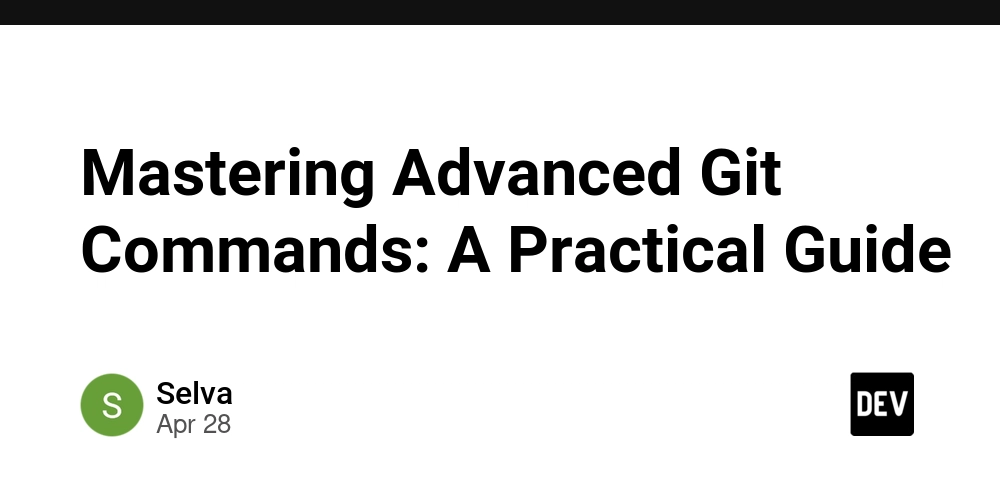Mastering Advanced Git Commands: A Practical Guide
If you’ve been using Git for a while, you probably know the basics — clone, commit, push, pull. But Git is a powerful tool, and there's a whole world beyond the basics that can make your workflow faster, cleaner, and smarter. In this blog, we'll dive into advanced Git commands that every developer should know! git stash — Save Work Without Committing Ever got stuck when you need to switch branches but don’t want to commit half-done work? git stash It saves your changes in a "stash" and cleans your working directory. Later, you can reapply the stashed changes with: git stash pop Tip: You can even stash with a message: git stash save "WIP: fixing login bug" 2.git cherry-pick — Apply Specific Commits Want to pick a single commit from one branch and apply it to another? git cherry-pick Great for moving small bug fixes without merging entire branches. 3.git rebase— Rewrite History Cleanly Instead of a messy merge, you can reapply commits on top of another branch: git checkout feature-branch git rebase main Makes history linear and clean. Interactive rebasing (git rebase -i) even lets you squash commits together! git rebase -i HEAD~5 You can pick, squash, or reword commits easily during interactive rebase. 4.git reflog — Find Lost Commits Deleted a branch or a commit accidentally? Don’t worry! git reflog It shows a log of everything you've done, including commits that aren't reachable anymore. You can recover with: git checkout 5.git reset — Undo Changes Soft reset (keep changes but unstage): git reset --soft HEAD~1 Mixed reset (unstage and keep working directory): git reset --mixed HEAD~1 Hard reset (dangerous! discard changes): git reset --hard HEAD~1 Use hard resets carefully — once changes are gone, they're usually gone for good unless you use reflog. 6.git bisect — Find Bugs Faster Git can automatically help you find the commit where a bug was introduced! Start bisecting: git bisect start Mark the current version as bad: git bisect bad Mark an older working version as good: git bisect good Git will checkout commits one by one — you test and tell Git whether it's "good" or "bad" until it narrows down the exact problematic commit. 7.git tag — Mark Important Points Use tags for releases, versions, or milestones. Create a lightweight tag: git tag v1.0 Create an annotated tag: git tag -a v1.0 -m "Release version 1.0" Push tags: git push origin v1.0 Or push all tags: git push origin --tags 8.git clean — Remove Untracked Files Want to remove junk (files not tracked by Git)? Preview what would be deleted: git clean -n Actually delete them: git clean -f Be very careful with git clean — it’s powerful! 9.git remote prune — Clean Up Deleted Branches Sometimes remote branches get deleted, but you still see them locally. Clean them up with: git remote prune origin 10.git shortlog — Summarize Contributions Want to generate a quick summary of who contributed? git shortlog -sn You'll get a list of contributors sorted by the number of commits! Final Thoughts Learning these advanced Git commands will: Save you time Help you recover faster Keep your repositories cleaner Impress your team! If you're serious about becoming a Git pro, practice these commands on a test repository first. Over time, they’ll become second nature. If you found this helpful, don't forget to ❤️ the post and follow for more tips! Feel free to comment your favorite Git tricks below!

If you’ve been using Git for a while, you probably know the basics — clone, commit, push, pull.
But Git is a powerful tool, and there's a whole world beyond the basics that can make your workflow faster, cleaner, and smarter.
In this blog, we'll dive into advanced Git commands that every developer should know!
- git stash — Save Work Without Committing Ever got stuck when you need to switch branches but don’t want to commit half-done work?
git stash
It saves your changes in a "stash" and cleans your working directory.
Later, you can reapply the stashed changes with:
git stash pop
Tip: You can even stash with a message:
git stash save "WIP: fixing login bug"
2.git cherry-pick — Apply Specific Commits
Want to pick a single commit from one branch and apply it to another?
git cherry-pick
Great for moving small bug fixes without merging entire branches.
3.git rebase— Rewrite History Cleanly
Instead of a messy merge, you can reapply commits on top of another branch:
git checkout feature-branch
git rebase main
Makes history linear and clean.
Interactive rebasing (git rebase -i) even lets you squash commits together!
git rebase -i HEAD~5
You can pick, squash, or reword commits easily during interactive rebase.
4.git reflog — Find Lost Commits
Deleted a branch or a commit accidentally? Don’t worry!
git reflog
It shows a log of everything you've done, including commits that aren't reachable anymore.
You can recover with:
git checkout
5.git reset — Undo Changes
Soft reset (keep changes but unstage):
git reset --soft HEAD~1
Mixed reset (unstage and keep working directory):
git reset --mixed HEAD~1
Hard reset (dangerous! discard changes):
git reset --hard HEAD~1
Use hard resets carefully — once changes are gone, they're usually gone for good unless you use reflog.
6.git bisect — Find Bugs Faster
Git can automatically help you find the commit where a bug was introduced!
Start bisecting:
git bisect start
Mark the current version as bad:
git bisect bad
Mark an older working version as good:
git bisect good
Git will checkout commits one by one — you test and tell Git whether it's "good" or "bad" until it narrows down the exact problematic commit.
7.git tag — Mark Important Points
Use tags for releases, versions, or milestones.
Create a lightweight tag:
git tag v1.0
Create an annotated tag:
git tag -a v1.0 -m "Release version 1.0"
Push tags:
git push origin v1.0
Or push all tags:
git push origin --tags
8.git clean — Remove Untracked Files
Want to remove junk (files not tracked by Git)?
Preview what would be deleted:
git clean -n
Actually delete them:
git clean -f
Be very careful with git clean — it’s powerful!
9.git remote prune — Clean Up Deleted Branches
Sometimes remote branches get deleted, but you still see them locally. Clean them up with:
git remote prune origin
10.git shortlog — Summarize Contributions
Want to generate a quick summary of who contributed?
git shortlog -sn
You'll get a list of contributors sorted by the number of commits!
Final Thoughts
Learning these advanced Git commands will:
Save you time
Help you recover faster
Keep your repositories cleaner
Impress your team!
If you're serious about becoming a Git pro, practice these commands on a test repository first.
Over time, they’ll become second nature.
If you found this helpful, don't forget to ❤️ the post and follow for more tips!
Feel free to comment your favorite Git tricks below!



































































































































































![[The AI Show Episode 145]: OpenAI Releases o3 and o4-mini, AI Is Causing “Quiet Layoffs,” Executive Order on Youth AI Education & GPT-4o’s Controversial Update](https://www.marketingaiinstitute.com/hubfs/ep%20145%20cover.png)
















































































































































































































































.png?width=1920&height=1920&fit=bounds&quality=70&format=jpg&auto=webp#)






















_Vladimir_Stanisic_Alamy.jpg?width=1280&auto=webp&quality=80&disable=upscale#)










































































































![Standalone Meta AI App Released for iPhone [Download]](https://www.iclarified.com/images/news/97157/97157/97157-640.jpg)

![AirPods Pro 2 With USB-C Back On Sale for Just $169! [Deal]](https://www.iclarified.com/images/news/96315/96315/96315-640.jpg)
![Apple Releases iOS 18.5 Beta 4 and iPadOS 18.5 Beta 4 [Download]](https://www.iclarified.com/images/news/97145/97145/97145-640.jpg)
















































![Did T-Mobile just upgrade your plan again? Not exactly, despite confusing email [UPDATED]](https://m-cdn.phonearena.com/images/article/169902-two/Did-T-Mobile-just-upgrade-your-plan-again-Not-exactly-despite-confusing-email-UPDATED.jpg?#)
















































